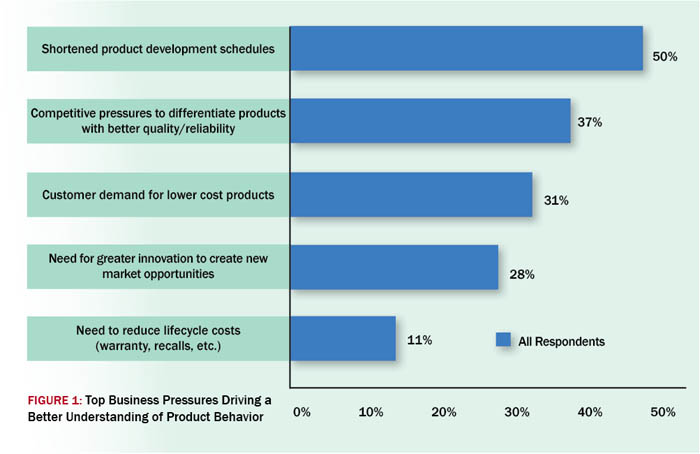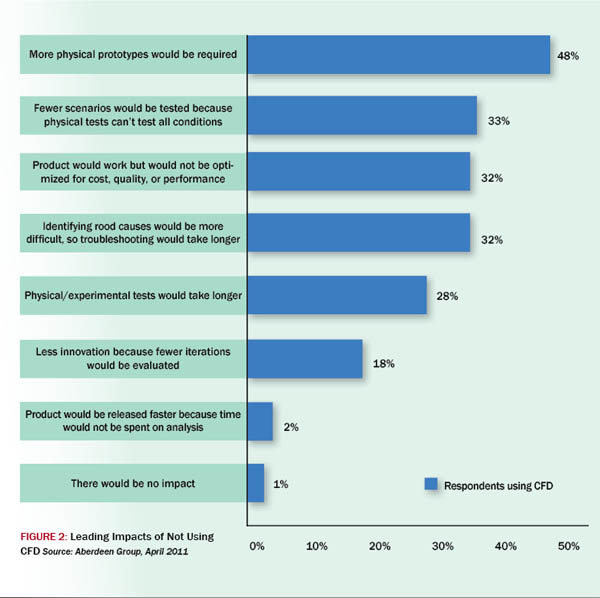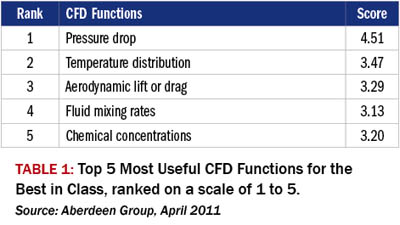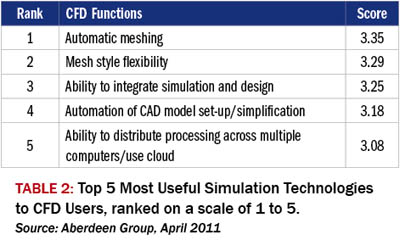Latest News
August 1, 2011
By Michelle Boucher
Previous research from the Aberdeen Group (the November 2008 Engineering Evolved study) found that those leveraging three or more different types of simulations are able to reduce the number of physical prototypes by 37%. For complex products, this reduction in physical prototypes leads to cost reductions of up to $332,673—and removes 118 days from the development process.
To explore this further, in a study released this spring, Getting Product Design Right the First Time with CFD, Aberdeen investigated the impact of computational fluid dynamics (CFD) on the product development process. For this research, those who developed products that would most benefit from CFD were isolated and their practices examined. These companies were identified as those whose products were affected by:
- air/gas flow
- fluid flow
- heating/cooling
- chemical reactions/combustion
- turbulence
- other related physical phenomena
Understanding Product Behavior
To understand the external factors driving companies to better understand product behavior during the development process, survey respondents whose products are affected by air or flow or other related physical phenomena were asked to pick their Top two external pressures. The top pressures are time and quality, followed by cost (see Figure 1).

Time-to-market pressure is driving shortened development schedules, and thus is the top pressure for product development. What is interesting about this is that findings from just last year (Cost Saving Strategies for Engineering: Using Simulation to Make Better Decisions, April 2010) found that cost was the top driving pressure while time came in second. This shift demonstrates that time is always an important pressure, but cost becomes even more important in a down economy. Suffice it to say, an improving business environment permits engineering efforts to focus on providing fresh and improved products to customers to fuel the organic growth companies want.
For some insight into how CFD helps address these market pressures, those using CFD were asked what the two biggest impacts would be if CFD were not used. The results are seen in Figure 2.

By using CFD, a variety of conditions can be tested without incurring the cost—or time delays—of building a physical prototype. When problems are found, CFD results can be used to better understand how the failure occurs, which makes arriving at a solution that much faster. Because more can be done in the virtual environment, it is easier to evaluate many design iterations to arrive at a cost-effective solution that will meet performance and quality criteria.
In addition, because more iterations can be evaluated, there are more opportunities to evaluate new innovations. Finally, because so much of the design can be validated virtually, physical test time does not need to be wasted on simple verification, but can instead focus on higher level testing. The end result of all of this is time is saved, quality goes up, and cost is lowered.
What is especially interesting is that 97% of respondents using CFD find value in it. Clearly, when products are affected by air or fluid flow or other related physical phenomena, CFD is a very important technology. However, what CFD software functions are the most useful? Those using CFD were asked this question—and the top five most useful functions can be found in Table 1. Respondents using CFD ranked each function on a scale of 1 to 5, with 1 being the least useful and 5 being the most.

The many types of different analyses that are possible with CFD were rated very useful, with pressure drop and temperature distribution being rated the most useful. The usefulness of each function will vary depending on product function, but these results show that pressure drop is widely applicable—and users find it to have a large impact on the performance of their products.
In addition, Aberdeen asked respondents who use CFD what were the most useful simulation technologies (see Table 2). The ability to automatically mesh the model, followed by the ability to tweak that mesh, was rated as extremely useful. Automatic meshing saves set-up time. While this is useful, more experienced users often want the flexibility to make tweaks to that mesh to either change the type of the mesh, or perhaps use a finer mesh in more critical areas and a looser mesh in areas that are less important to reduce processing time.
 The ability to distribute simulation processing across multiple computers or in a cloud is also rated to be useful. As more companies adopt cloud-computing technologies, the usefulness of this capability is likely to increase, as it relieves desktop computers of the computational intensity of the simulation so that other work can be done. With more computation power to process the simulation, it also reduces the time needed to arrive at results.
The ability to distribute simulation processing across multiple computers or in a cloud is also rated to be useful. As more companies adopt cloud-computing technologies, the usefulness of this capability is likely to increase, as it relieves desktop computers of the computational intensity of the simulation so that other work can be done. With more computation power to process the simulation, it also reduces the time needed to arrive at results.
Key Takeaways
Those using CFD find it adds a lot of value to the development process. The complexity of today’s products makes it difficult to predict product behavior without supporting tools to help them obtain better insight into how that product will perform in a real-world environment. CFD helps them do just that—and as a result, they are better positioned to meet the top business pressures of bringing new products to market as quickly as possible, with a high level of quality, while keeping costs down.
Michelle Boucher is a research analyst in the Product Innovation and Engineering practice at Aberdeen Group, where she focuses on identifying product development best practices. She has published more than 50 studies on the use of CAD, CAE, PLM and other topics, including manufacturing planning, systems engineering and mass customization.
For More Information:
Aberdeen Group
Subscribe to our FREE magazine, FREE email newsletters or both!
Latest News
About the Author
DE’s editors contribute news and new product announcements to Digital Engineering.
Press releases may be sent to them via [email protected].






